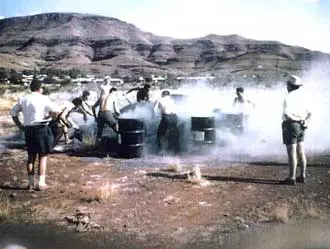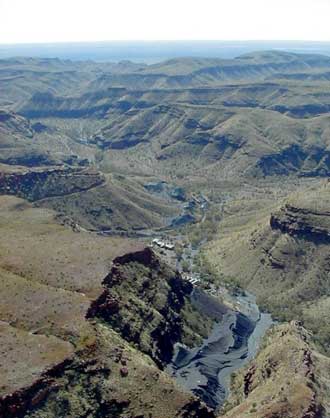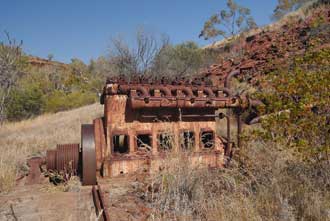There is something very bitter-sweet about Wittenoom. This near ghost town set at the mouth of the Wittenoom Gorge is the home of Australia's greatest industrial disaster and yet it is located in one of the most beautiful areas of Australia.
Some 1450 km north of Perth and 460 m above sea level, this once thriving settlement is in the heart of the beautiful Hamersley Range, close to the popular Karijini National Park. It is ideally located for people wishing to visit the numerous gorges which cut through the range, in fact, for many years it was the service town to Karijini, and the logical place to stay when visiting the Park.
However, as everyone in Australia now knows, Wittenoom is also in a valley of death. The signs around the town call attention to the problem: "DANGER - Asbestos Tailings Risk Area. Inhaling Asbestos Fibres May Cause Cancer."

Of course no such problems confronted Francis Gregory who led an expedition into the Hamersley Ranges in 1861. It was this expedition which reported back to Perth on the rich pastoral potential of the Pilbara region and was responsible for the establishment of the towns of Roebourne and Cossack. The land around Wittenoom was subsequently settled and Wittenoom Gorge was named after the pastoralist and politician Sir Edward Horne Wittenoom (1854-1936).
The area remained pastoral, and very isolated, until the 1930s. The West Australian Mines Department had known of the asbestos in the area since 1917 but it was not until the 1930s that the mineral was mined. Early prospectors mined the crocidolite fibres with a pick and shovel. With the beginning of World War I, there was a sudden demand for asbestos for use in tanks, planes, battleships, helmets and gasmasks.
In 1936, mining magnate Lang Hancock expressed interest in working the blue asbestos deposits in the Wittenoom Gorges. In 1938 he secured several mining leases in Wittenoom and in 1940 began mining operations. A year later, Colonial Sugar Refinery (CSR) took over Hancock's interests. In 1943 a mine imn Yampire Gorge was opened. Production at the Yampire Mine to 1946 is estimated at 15,000 tons of ore for about 3,000 tons of asbestos fibre.
The town of Wittenoom was established in 1947 to house the workforce of the Wittenoom mine and mill 10 km away. There were horrendous dust levels recorded in the mines and mill. The climate at Wittenoom is hot and humid in summer, which made working conditions in the poorly ventilated, dusty mine and mill even more uncomfortable.
CSR had problems attracting workers to the mine and mill, and in 1951 wrote to the Department of Immigration asking for help as the Australian Government was still recruiting immigrants from post war Europe. CSR sent representatives to European countries, such as Italy, to recruit workers. Many European immigrants unable to find work in their own country signed a two-year contract with CSR to work at the Wittenoom mine and mill.
During the 1950s the diseases caused by exposure to blue asbestos (asbestosis, lung cancer and mesothelioma) began to be recorded and publicised but the warnings were played down by the mine operators, and Governments failed to act. The mine workers, particularly those who did not speak or understand English very well, were poorly trained and were not aware of the health risks associated with the asbestos dust.
 Workers shovel raw blue asbestos tailings into drums at an asbestos shovelling competition at Wittenoom in 1962
Workers shovel raw blue asbestos tailings into drums at an asbestos shovelling competition at Wittenoom in 1962
Crocidolite tailings from the tailings dump were spread around the town as a cheap gravel and sand substitute as there was very little sand around Wittenoom. Australian Blue Asbestos spread the tailings around its buildings in Wittenoom and the town's State Housing homes. The tailings were also used by the Shire of Ashburton, the Public Works Department and the Main Roads Department on local roads around the town, at the golf course, race course, airport, drive in cinema and caravan park. Tailings were also used for concrete slabs and pads for houses.

Where is it?
1,106 kilometres north-north-east of Perth, 140 km from Tom Price in the Hamersley Range in the Pilbara region of Western Australia.
By 1966 the last operating mine was closed, not because the health warnings were finaslly being heeded, but for economic reasons. The town fell into decline and by 1994 Wittenoom's population had dwindled to around 40 (including one child) and the town depended almost entirely on tourism for its income. What remained were unsafe mine sites, huge dumps of tailings and a town extensively contaminated with asbestos tailings. Numerous attempts were made to ban the use of the tailings but it was still considered safe to incorporate the tailings into concrete as they were sealed.
The horrors of Wittenoom can be easily measured today by the harsh fact that of the 20 000 men, women and children who lived and worked in Wittenoom during the mining boom, over 1000 (and the figure is still rising) have died from the asbestos-related diseases of asbestosis, lung cancer and mesothelioma. It is now estimated that over 25 per cent of all the men who worked in the mines will die of asbestos-related diseases.
Legal proceedings insitituted by victims of mesothelioma and other asbestos-related diseases have attracted the attention of the media and maintained the high profile of asbestos and Wittenoom since the mine was closed.

In 1978 the State Government began phasing down activity in the town of Wittenoom. It encouraged residents to relocate out of Wittenoom voluntarily through the purchase of their homes, business and property and included a contribution to their relocation costs. A recommended systematic clean up of the town was not undertaken.
Between 1986 and 1992 around 50 houses and other buildings were demolished by the Government. The Fortescue Hotel was closed in 1992. When the population decreased, the school, nursing post and police station were closed, with alternative services being provided primarily from Tom Price. In 1993 the airport was closed and the Government advised the Wittenoom residents they would not be forced to leave, but new residents would not be encouraged to the town.

By June 2007, when the town was officially wiped off the map, its population had fallen to seven. The few buildings that still remain are owned by people who have refused the Government's offers to purchase their properties and re-locate them. Kangaroo shooters stay in the town during the wet season when there are plenty of kangaroos around the area. Telstra provide a telephone service through a solar powered unit located outside the town. In 2006, electricity supplies to the town were turned off, mail deliveries stopped and police patrols halted. At that time, 30 of the then 37 remaining residents left Wittenoom.
The few residents now left argue that the current level of airborne asbestos in Wittenoom is seven times less than the level recorded in Perth in 1978. However, this is not the view of the Shire of Ashburton and the Health Department of Western Australia which advocate the avoidance of the Wittenoom area.
There are signs located at the entrance to the Karijini National Park warning tourists of potential health risks in the gorges and the town.
 Yampire Gorge mining relics
Yampire Gorge mining relics
Design by W3Layouts | Content © 2013 Phoenix Group Co. | Sales: phone 1300 753 517, email: [email protected]

